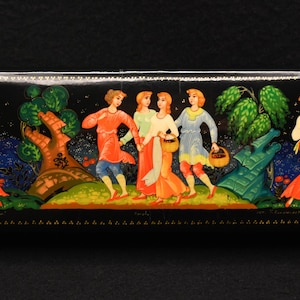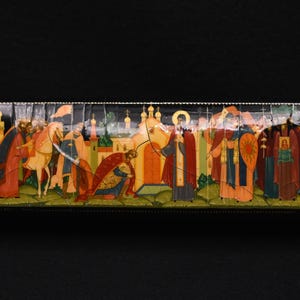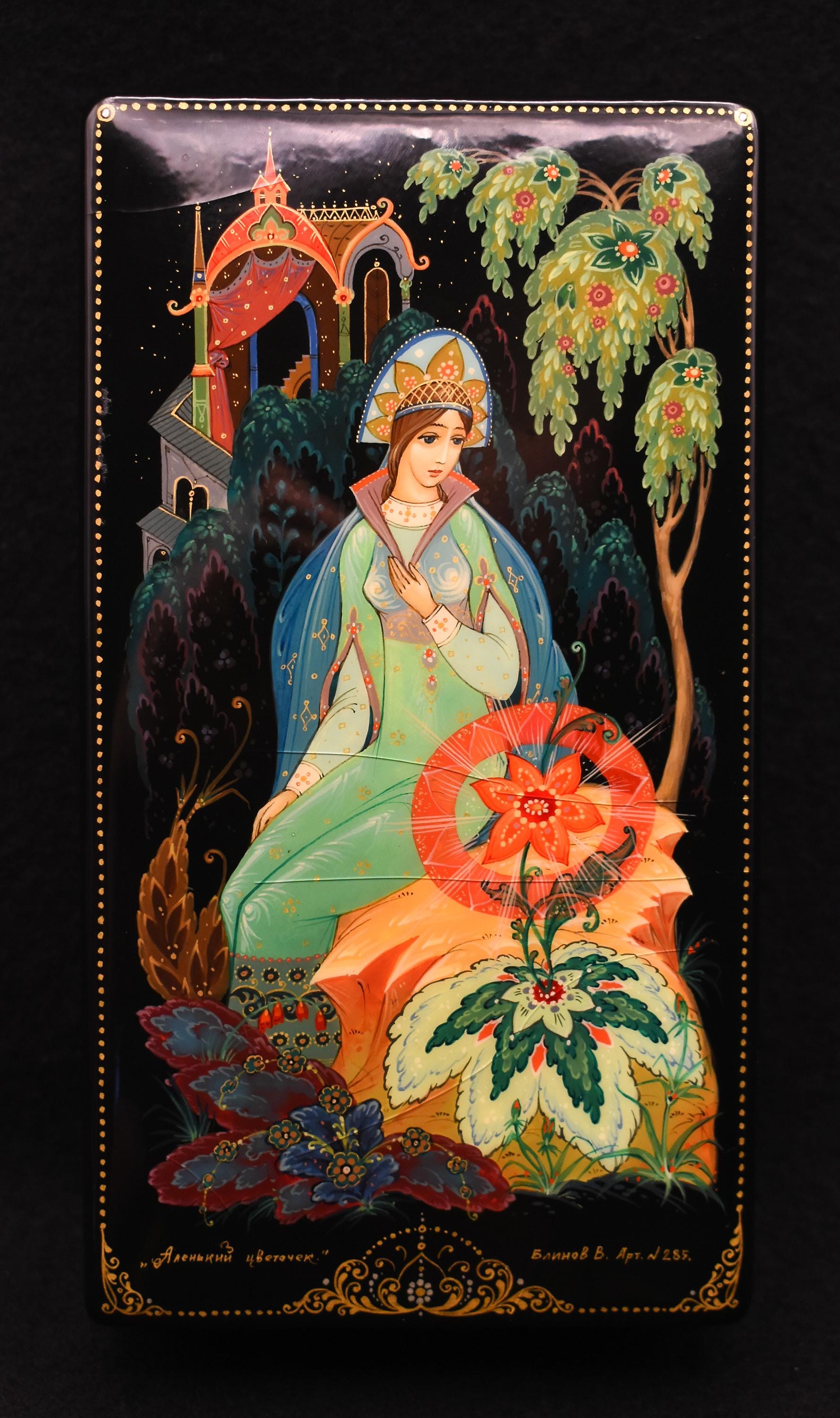
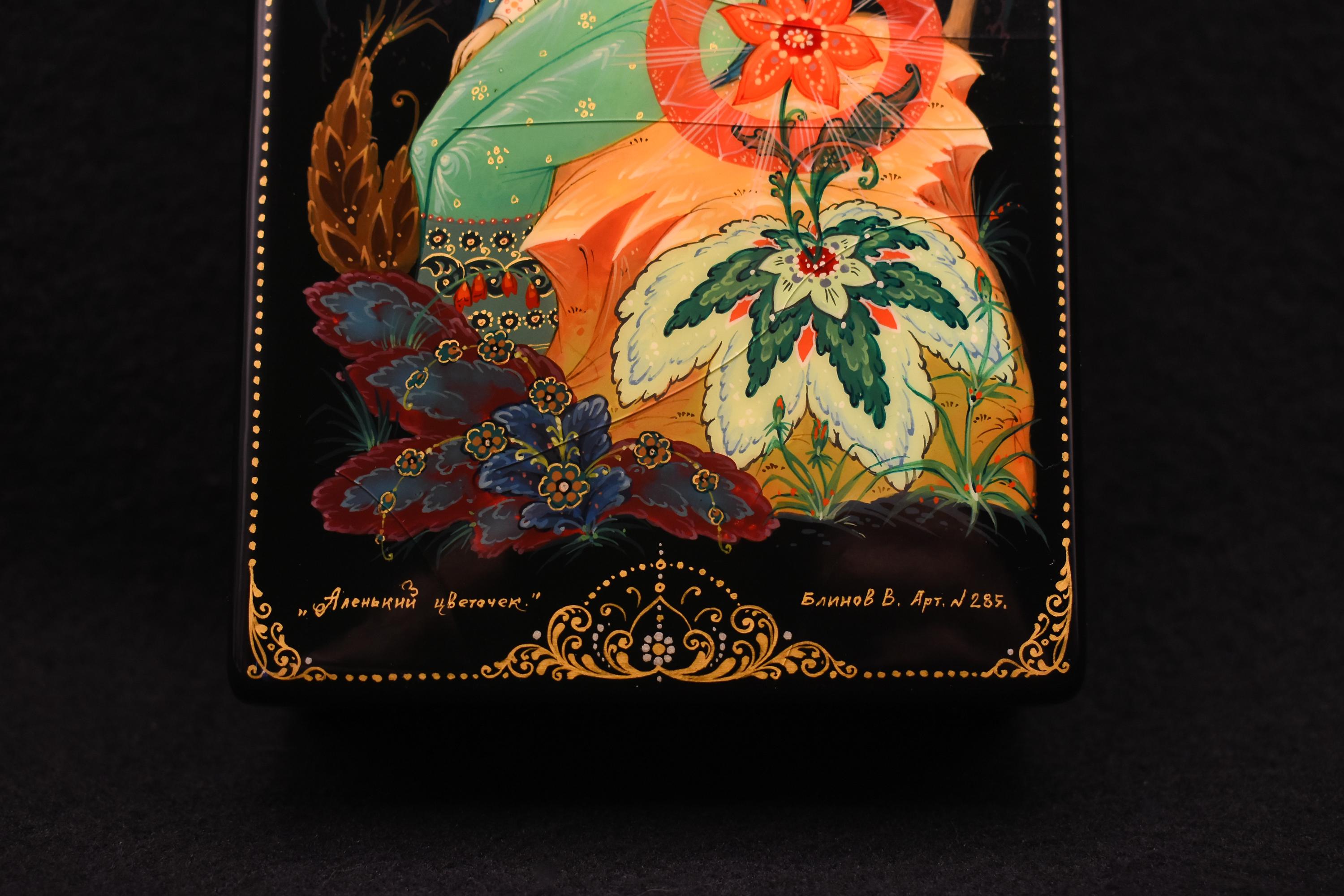
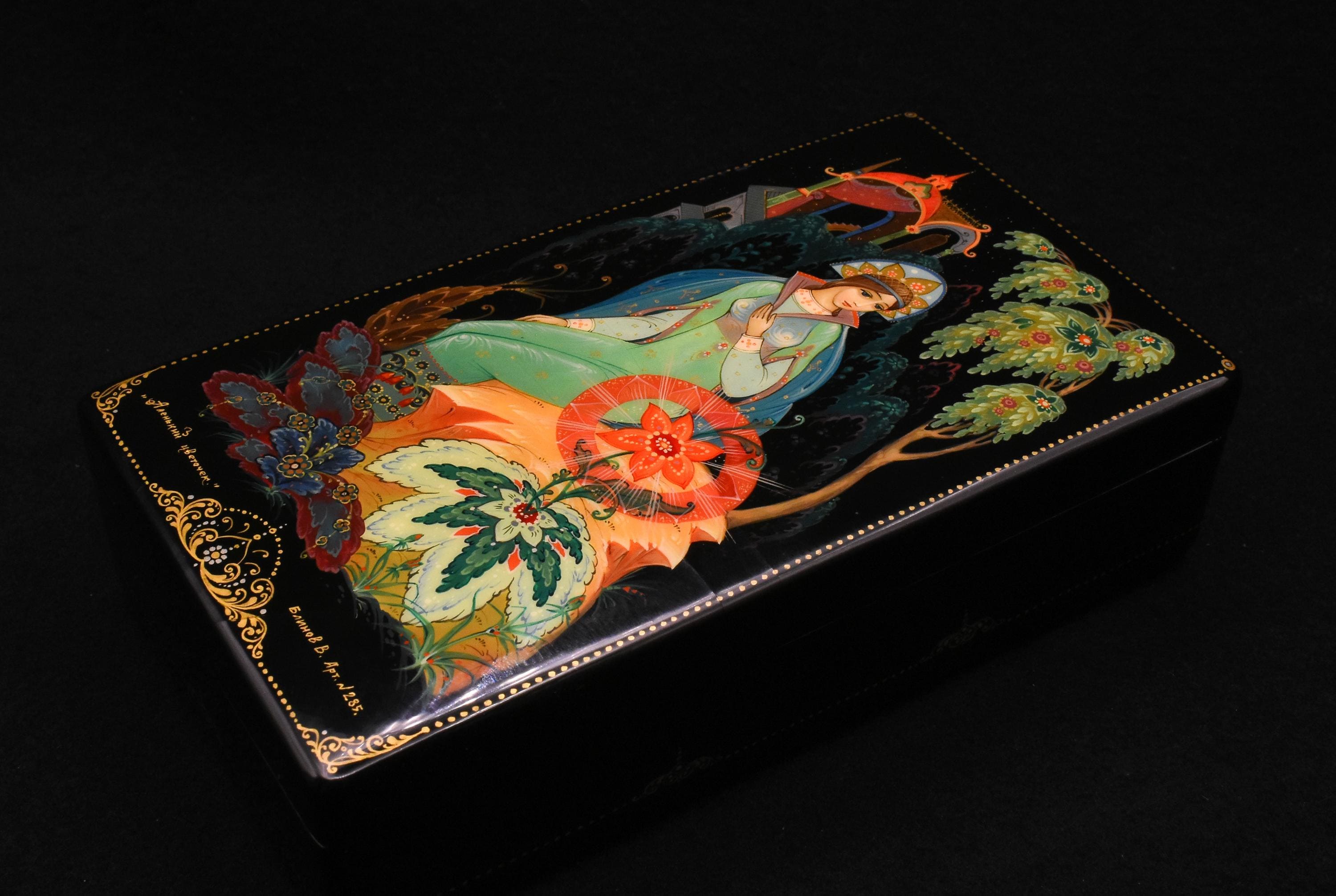
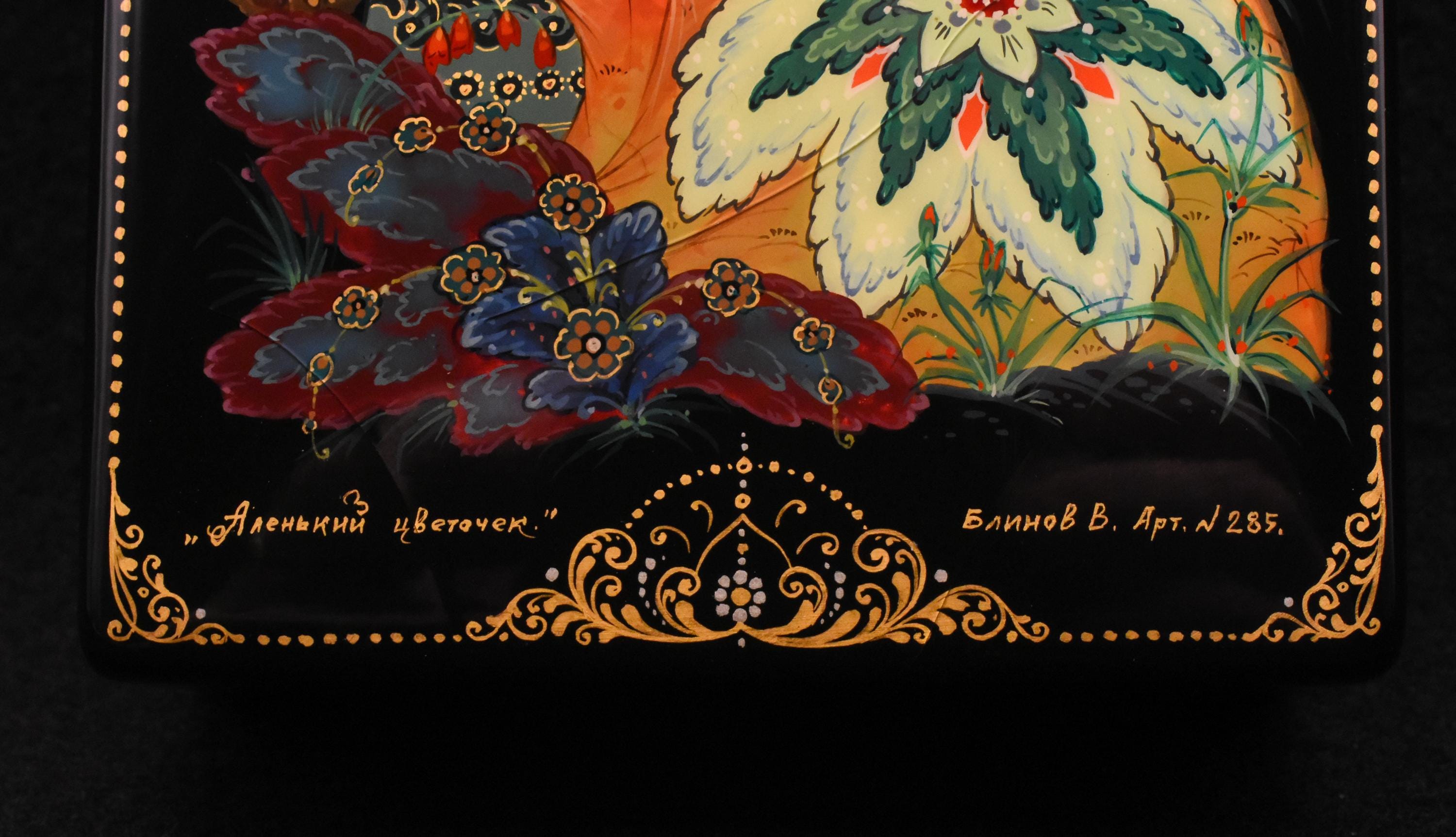
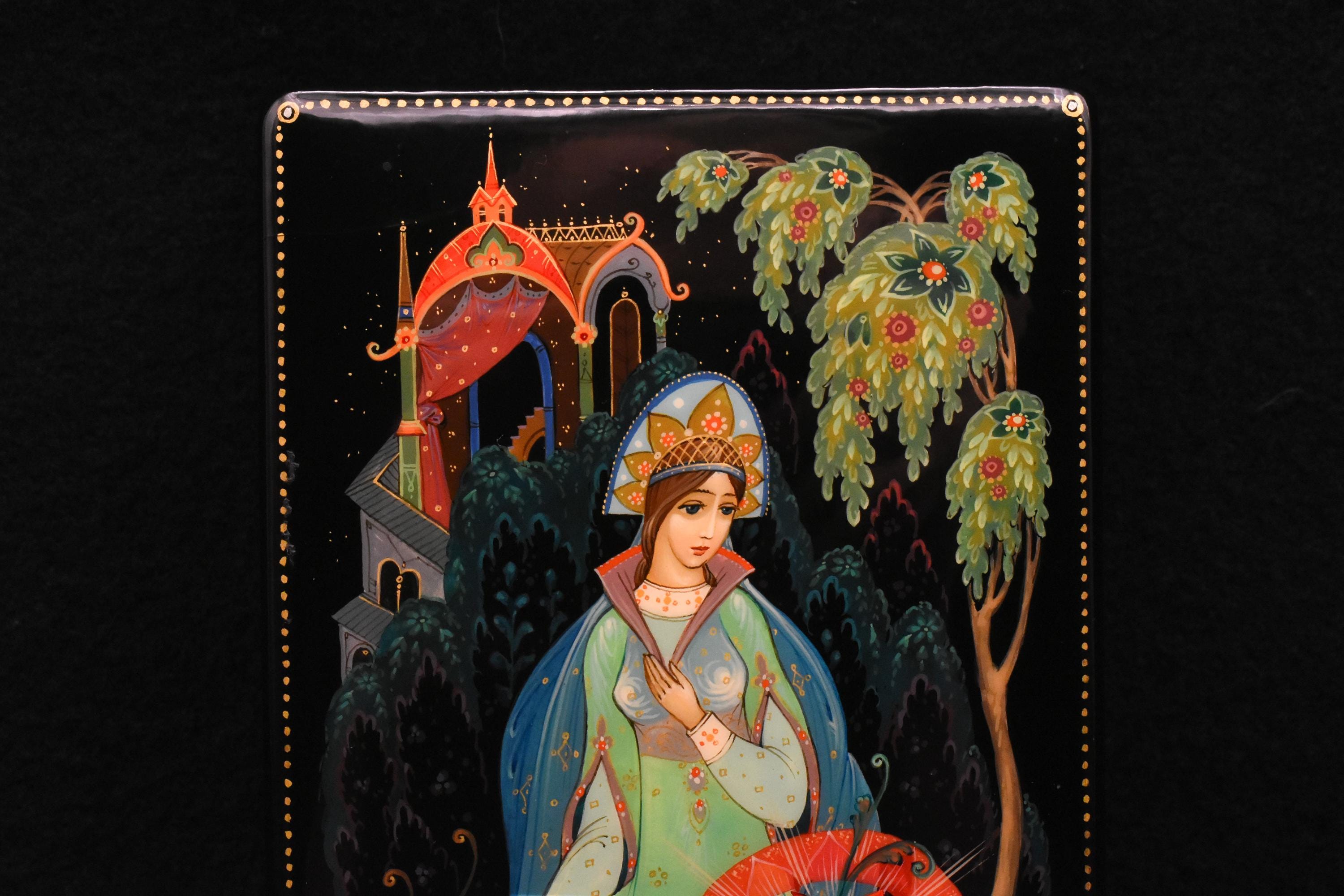
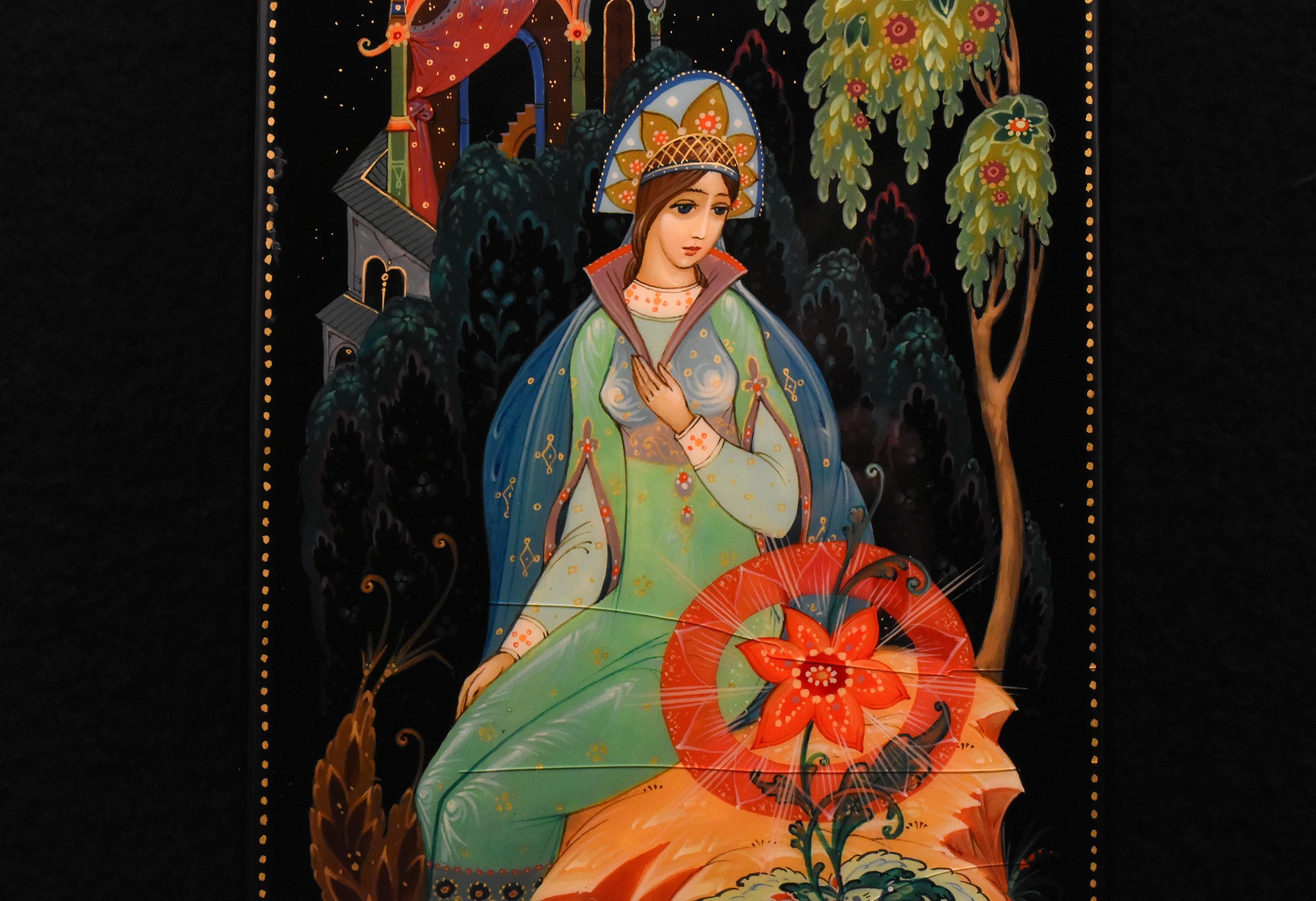
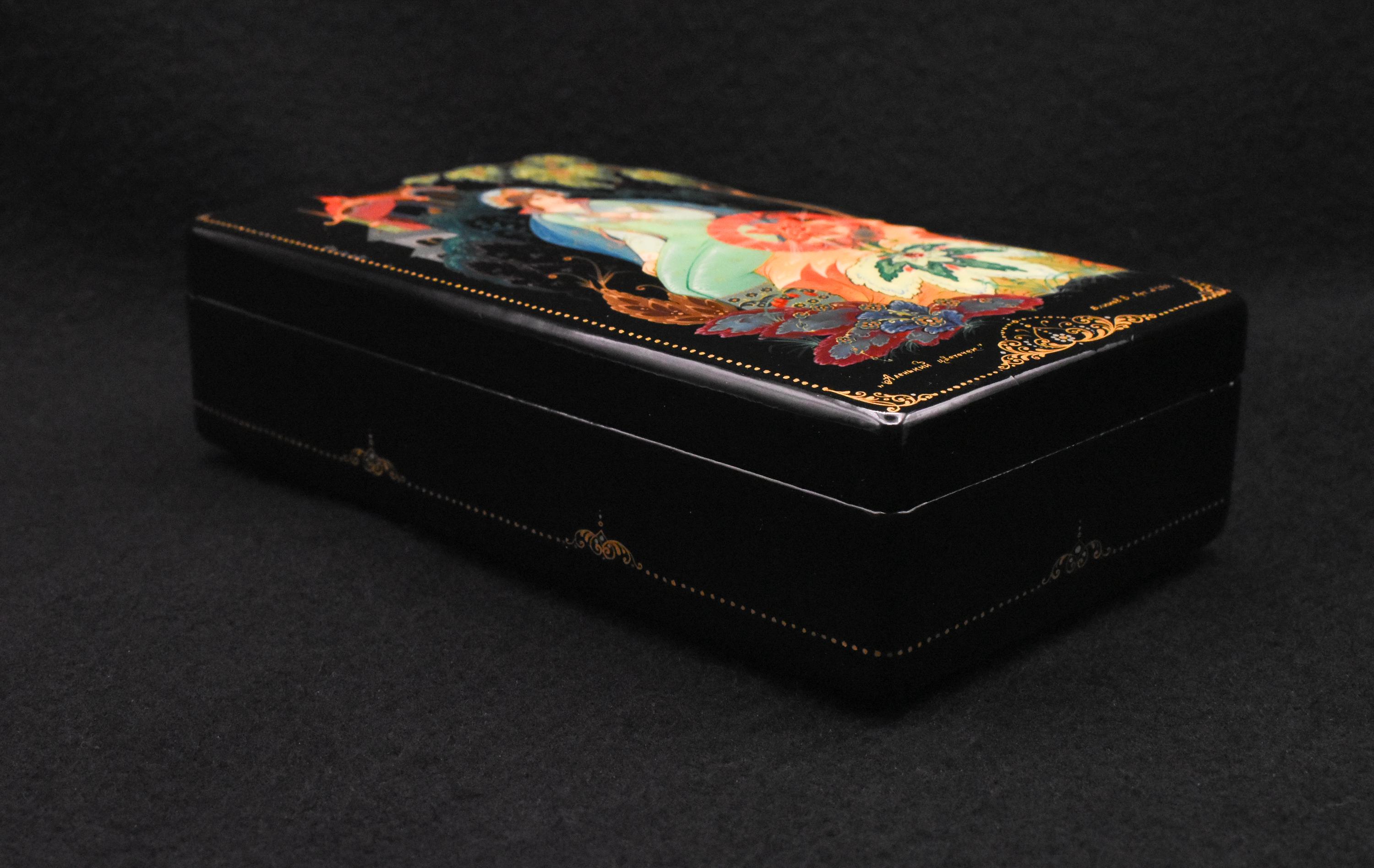
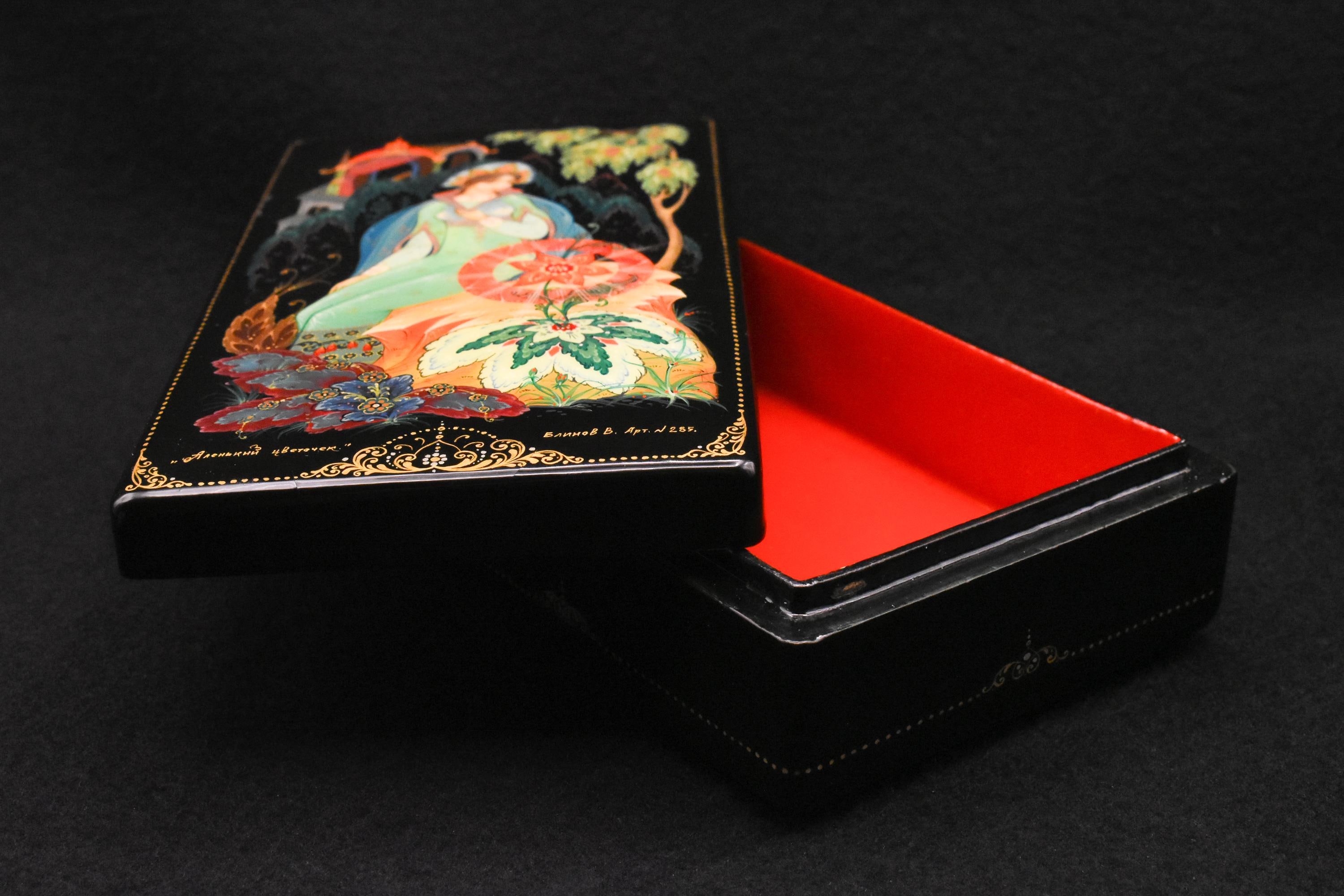
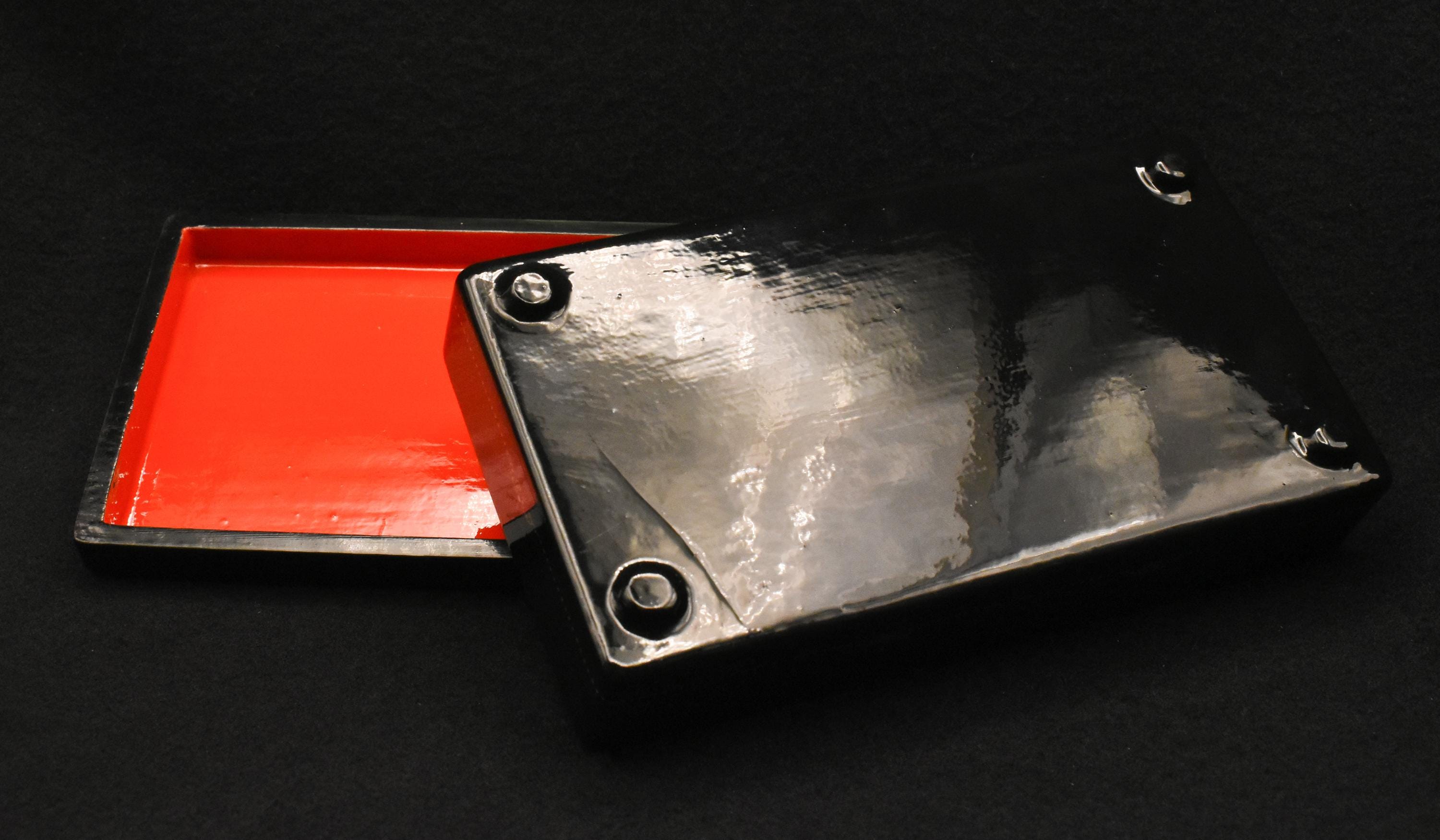
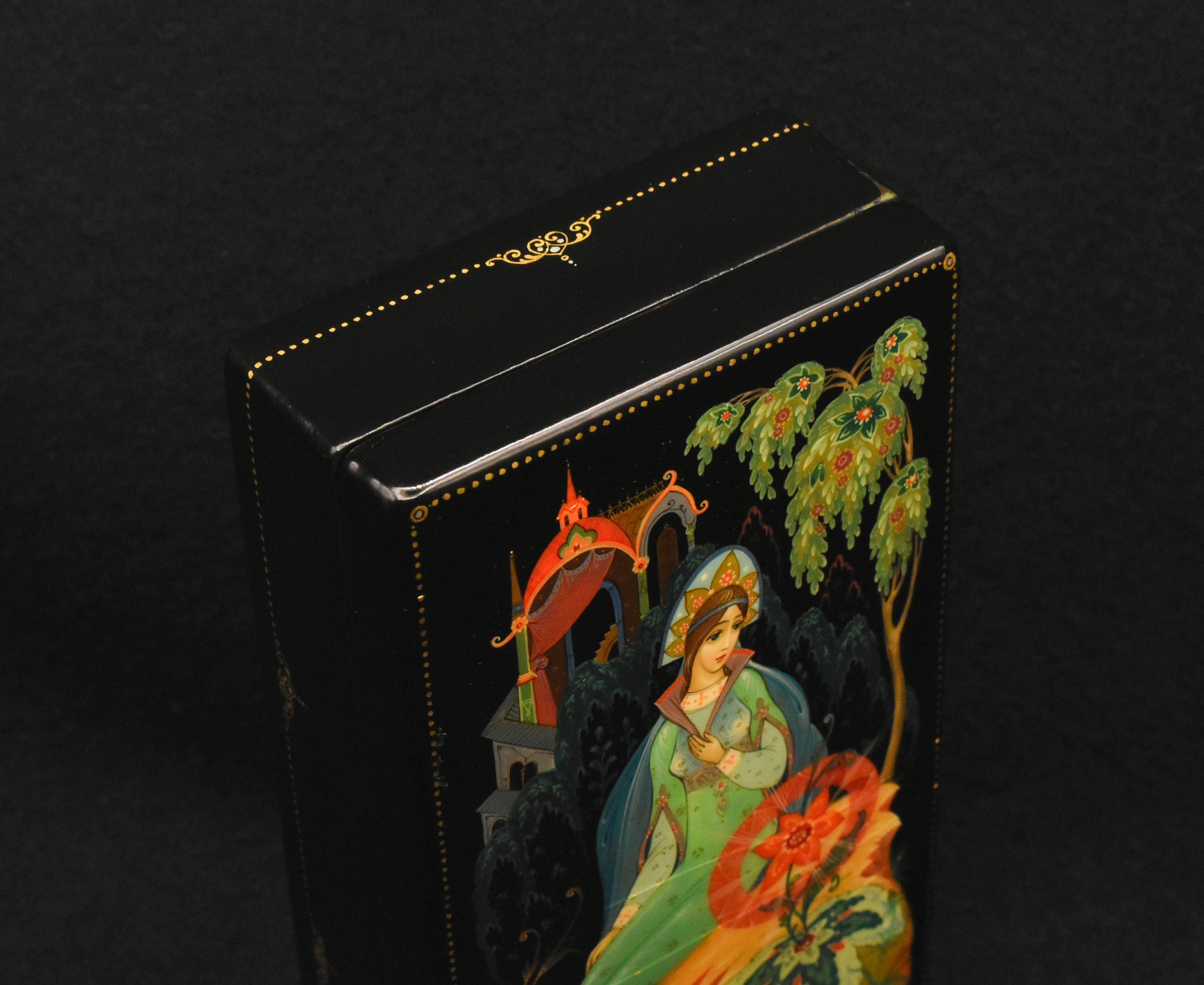
Prints and Art
Stunning Soviet/Russian Papier Mache Lacquer Box - Beauty and the Beast - Imperfect
-
DetailsThe following history is repeated for all the lacquer boxes in my collection - please scroll down to the paragraph break for product-specific description.
Some of you might be familiar with these stunning Russian boxes, but few know the story of their origins. It actually began over 200 years ago...
Miniature lacquer painting began in the village of Danilkovo (now Fedoskino), near Moscow. Artists began developing the techniques that would spawn Russian lacquer boxes in the late 1600s, cutting their teeth in the realm of religious art. Danilkovo was the center of the art of creating religious icons (highly-sought-after paintings of religious symbols and characters). Having developed some truly breathtaking painting techniques (including using liquified precious metals such as gold and silver, and painting with a single hair follicle, resulting in some of the most spectacular detail many had ever seen), it was the natural birthplace of these stunningly intricate boxes. Within 50 years, 3 other villages would join the guild of artists, becoming famous the world over for some truly staggering art. Each town, Fedoskino, Palekh, Kholuy and Mstera had a lengthy history, with regards to iconography and elite artistic creations, so they were natural destinations for the artistic communities that would grow around the Russian capital. As time progressed, each town and their respective artists formed specialized and very selective schools to disseminate their skills, and as such, developed their own style. Although the revolution of 1917 damaged not only the desirability but even legality of the religious subject matter of many of these artists and their craft, they persisted to keep their crafts alive. They survived the oppression of much of the 20th century and even began to flourish again, in the last half of the 20th century. Even today, these schools are formed of the most elite and talented painters in the country, although the majority of the most amazing pieces are created by artistic descendants, going back up 5 generations! Their creations are infinitely impressive in the application of these stunning pigments and details, much as their parents and grandparents before them.
Starting in the 1800s, these boxes were made specifically of a papier-mâché base. Each would take approximately 6 weeks to complete and would include a base of linseed oil, rendering it impervious to moisture. This method also ensured a stable base that would not warp and does not change size due to temperature changes or fluctuations in humidity. Only once completed and approved by a master, the painting process would begin. First, it passes through the hands of an apprentice who ensures a smooth base of colour - the interior is painted bright red and the exterior a deep black. When the master painters get their hands on these pieces is when the magic truly begins. Using a magnifying glass, in many cases, and the richest and brightest oil-based pigments available, the master painter applied the stunning colours and textures you see here. You might be drawn to the glittering of the border or the signature along the bottom. However, this application of pigments made of true 24 kt gold and pure silver is visible throughout the piece. Because the 4 towns specialized in their own methods and styles, one can tell apart the pieces based on their colours and textures, the subject matter within, as well as the methods of applying their magnificent pigments.
These 4 towns still produce these stunning pieces today, although after the fall of the USSR in 1991, their quality waned. The popularity of these boxes skyrocketed with international recognition and, naturally and most-unfortunately, this resulted in a veritable flood of counterfeits and fakes. Luckily, manufacturers of fake pieces are not patient, so the box itself doesn't go through the rigours of proper papier-mâché manufacture. The fakes are made of plastic or resin, so they're easily identified. One could find a slight grid pattern on the base, indicating a machine-made box. The linseed oil base would start to settle after 6 months or so, releasing a distinct odour, so the interior has a definite 'antique' smell to it, nearly impossible to replicate with a resin box. The weight of the fake boxes would be significantly heavier, as well - papier-mâché is very light. The texture of the box would easily reveal the content, as well. One must simply tap or flick the bottom of the box. If there's a sharp sound or a click, it's not the genuine article. Papier-mâché boxes sound muted, almost soft, when tapped. Lastly and most-importantly, we must examine the image itself. Is there the depth that comes with layers of meticulous application of lacquer? A magnifying glass is very useful in finding these imperfections and identifying a fake. Normally, I rely on artist signature and information that is legible, but early boxes (especially created by masters) rarely featured legible signatures. As such, we must frequently examine further. What about the colours and pigments used? The colour of the box, under intense LED light, shows a slight green pigment to the black portions of the box, with gold elements showing through. This is a known denaturing of colours, especially if the piece suffered some neglect (apparent from frequently-cracking lacquer), so that gives us yet more information as to the legitimacy of any given piece. The detail and brush-strokes are just staggering - impossibly minute details and pigment-mixtures show meticulous detail, but we must be wary of counterfeit items. My evidence of authenticity, however, is found in a most unusual place. See, the condition of our box is sadly wanting... the last half-century has not treated this piece with much respect. The lacquer on the surface is cracked - we can see unbelievably thin lines on the image corresponding to these cracks, where the pigments are separating with the lacquer under which they are placed. Fakes are not uncommon, but with these fakes, it is very obvious to see a 'sticker' that is placed onto a plastic box, representing the purported painted image. Cracks in lacquer make these stickers stand out painfully. This, I assure you, is not a plastic box - the texture and sound indicate genuine Fedoskino/Kholui/Mstera/Palekh papier-mâché, and it would be exceedingly unlikely that a fake item would use a genuine papier-mâché box. Further, under magnification, the edges are beautifully untidy - along almost the entire edge of the image, one can see the impossibly intricate brush strokes that are the limits of the image. The authenticity of this particular piece (as well as all the others you'll find at C&K) can not be disputed, however. You see, this piece was imported by my grandfather almost 40 years ago. In the 80s and early-90s, he owned a Russian Art and Toy Store in West Edmonton Mall. He successfully ran his store for several decades, but his stock wasn't ordered or shipped-in. Every other year, as a former citizen of the Soviet Union, (he immigrated with his/my family in the early-70s) he would take a trip to Russia. He was aware of these staggering pieces of art and would do so specifically to visit these towns firsthand, purchase, pack and import these pieces, himself. Over the years, he formed some very close friendships with these artists, watching their children take up their parents' posts and inheriting their remarkable talents. He would bring only 2 or 3 changes of clothes, but brought no fewer than 4 full-size suitcases, brimming with simple gifts for these remarkably talented families who were practicing under a brutal Soviet regime. When he brought these crafted riches home, it would be quite an event, unpacking the treasures and marveling at their colours while he and my grandmother regaled me with the tales of their subjects... Sadly, he passed away last year. Although I have kept a great deal of his stunning pieces, I am simply inundated with the vast quantity of boxes he has left me. As such, I have decided to offer them for sale.
The artistic merit of the piece is no longer in question, nor are the origins of this stunning, lidded box, but what is the picture?
Normally, the folk tales about which these pieces are crafted are rooted in Russian culture. They are frequently centuries-old stories involving unfamiliar characters and complicated plot-lines. It is difficult to re-tell these tales adequately, given the limited space of online descriptions. In this case, however, it's a far easier task. This is a tale that has been told for centuries, but is one any Disney fan would be intimately familiar with - Beauty and the Beast.
The original tale was written by Gabrielle-Suzanne Barbot de Villeneuve in 1740, but it was a lengthy tale (much like many of the Russian tales covered in many of these boxes). However, in 1756, French novelist Jeanne-Marie Leprince de Beaumont abridged and re-wrote the story for publication. It was a masterful retelling and quickly became a popular story among children and adults, alike. It was re-written again in 1889, by Andrew Lang, and it is this version that Disney made so popular. However, I will summarize the original tale, as recognized in Russian folk culture, for relevance to our piece.
It is known under the title "The Scarlet Flower," or "The Little Scarlet Flower." It was recalled by Sergey Aksakov in 1856, in a letter to his son. He recalled the tale as one told to him in his youth, by a housekeeper named Pelageya, late one night by a glowing wood stove. He eventually published the story in his collection of children's tales, in 1858, and the rest, as they say, is legend.
It starts with a wealthy merchant who was on his way abroad. He had three beautiful daughters and asked them if he could bring anything back for them. The eldest requested a beautiful tiara adorned with jewels and gold, that sparkled like the night sky. The second eldest asked for a crystal mirror which would show the gazer an image of them as youthful and beautiful, always. Although difficult finds, the merchant thought these objects were within his means. The youngest, named Nastenka (a diminutive form of the name Anastasia), requested the most beautiful scarlet flower in the world, which she had seen in a dream. Unsure how he would find such an item, the merchant nonetheless agreed and went on his way. While on his voyage, the wealthy merchant was attacked by robbers and, terrified for his life, fled deep into the woods. He became lost and in his terror, fell asleep. When he awoke, he found himself near a beautiful palace, glowing and shining in the sun, "in flame, silver and gold." Upon entering the palace, he found it empty. However, sat upon the dining table was a spectacular feast of wonderful and varied dishes. He ate his fill and began exploring, walking the beautiful grounds and stumbling upon a magnificent garden. In this garden grew a simply spectacular scarlet flower - the very item his young Nastenka requested. He plucked the flower and no sooner had he done so than a ferocious and terrifying Beast of the Forest pounced on him and snarled that he had taken his most precious item - the one thing that brought him joy, in this world. The Beast demanded he repay his ignorance with his life. Begging for mercy, the merchant requested that the Beast allow him to return to his beloved daughters. The Beast agreed, under one condition - that upon his return, the merchant would send one of his daughters back to the palace, to willingly live with the Beast, in his place. If not, the merchant's life would be forfeit. Reluctantly, the merchant agreed. The Beast gave the merchant a small golden ring, which, when placed upon the smallest finger of the right hand, would instanlty transport the daughter of his choosing to the palace. He then magically transported the merchant home, with his wealth and treasures restored. When he returned, he told his daughters of his voyage and, being cruel and selfish, the two older daughters agreed that the youngest should be the one to go, given it was her gift which caused the disastrous situation. Her love for her father was so great that Nastenka agreed to go. Upon her arrival at the palace, she was showered with the most beautiful riches and sumptuous foods. All her wants and deeds were met with luxurious excess, so that she wanted for nothing. However, the Beast refused to reveal himself, ashamed of his appearance and afraid that he would scare his beautiful young guest. Eventually, Nastenka became very fond of her host and begged that he revealed himself to her. Although terrified of his image when he did, she controlled herself and apologized to the kind Beast for her reaction. As time passed, they grew fonder of each other, the Beast falling deeply in love with his young visitant. One night, Nastenka had a dream that her father was very ill and begged the Beast to allow her to go visit him. Although now deeply in love with her, he agreed that she could go for 3 days, but must return lest he die of heartache at her absence. Although she did not love the Beast, her infinite kindness bade her to agree because she could not bear hurting him. Upon her return home, her presence instantly raised her father's spirits and he grew stronger. However, her sisters resented the young beauty for living in such opulence. They tricked her, turning back the clocks and closing the windows so she lost track of the days and missed her 3 day deadline to return to the Beast. Feeling that something was desperately wrong, Nastenka eventually escaped and returned to the palace. There, she found the beast as he lay dying next to the wilting scarlet flower. She rushed to his side, professing her undying love for him and admitting that he was the love of her life. Instantly, thunder boomed and she found herself on a golden throne, seated next to a handsome prince. He explained that a witch who had warred with his father had put a curse on him, to be broken only with the revelation of true love. She had freed him from his beastly prison and they went on to love happily ever after.
It's familiar and has most of the aspects of the popular, modern tale. Regardless of the content, it's a beautiful tale of the blindness of true love.
As for our piece, it's truly one of the most beautiful pieces I have had the pleasure of seeing - even by the high standards set by these treasures. Her face, the colours of her dress, the palace in the background and even the ethereal glow of the flower seem to radiate from the inky blackness of the background. The shading and textures of the tree trunks and her clothing and the tiny details of her cuffs and the leaves of the trees are simply amazing. The gold and silver sparkle throughout, from the stars in the sky to the delicate details in Nastenka's dress, the palace and even to the flowers at her feet. The Scarlet Flower radiates with beautiful silver detail and dotted with gold. The border is simple, dotted, but the very bottom of the border and the bottom corners are intricately stunning, showing the true masterful skill of the artist. The border is made of gold, with silver accents, as is the border surrounding the lower half of the box. Along the bottom are the details of the piece. Along the left, "Alenkiy Tzvetochek" (The Small Scarlet Flower) and along the left, the artist and their number (Blinov V., Artist N285). Although the town of manufacture is absent, we know that this level of colour and detail belongs only to a true artist of Fedoskino, the most desired and talented of craftsmen. The very bottom of the box has 4 small legs to raise the box off the surface. It is truly a spectacular and wondrous piece of art and a stunning example of Russian lacquer boxes.
The condition is not perfect, sadly. While in storage, moisture has affected the lacquer and resulted in several cracks. On the very bottom of the lower box is a single, small crack. On the surface, there are 4 or 5 tiny cracks. Luckily, the pigments and details underneath has suffered absolutely no loss to their vibrancy or intricacy. Although imperfect, I am truly infatuated with the beauty that radiates from this piece, and I truly hope you see it too.
As always, should you have any questions or comments, please don't feel shy to reach out. I'm always happy to respond to any queries.
Thank you very much for visiting C&K! -
Shipping & Policies
Shipping from Canada
Processing time
1-2 business days
Customs and import taxes
Buyers are responsible for any customs and import taxes that may apply. I'm not responsible for delays due to customs.
Payment Options
Returns & Exchanges
I gladly accept returns and exchanges
Just contact me within: 3 days of delivery
Ship items back to me within: 7 days of delivery
I don't accept cancellations
But please contact me if you have any problems with your order.
The following items can't be returned or exchanged
Because of the nature of these items, unless they arrive damaged or defective, I can't accept returns for:
- Custom or personalized orders
- Perishable products (like food or flowers)
- Digital downloads
- Intimate items (for health/hygiene reasons)
Conditions of return
Buyers are responsible for return shipping costs. If the item is not returned in its original condition, the buyer is responsible for any loss in value.
Frequently Asked Questions
Can I combine delivery on multiple items?
Of course! We'd be happy to assist. Just send us a quick message and we'll make sure to combine your items into a single package to reduce the shipping costs.


